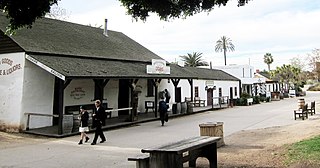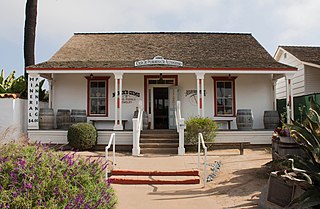
Old Town San Diego State Historic Park is a state protected historical park in the Old Town neighborhood of San Diego, California. The park commemorates the early days of San Diego; it includes many historic buildings from the period 1820 to 1870. The park was established in 1968. In 2005 and 2006, California State Parks listed Old Town San Diego as the most visited state park in California.

The Centinela Adobe, also known as La Casa de la Centinela, is a Spanish Colonial style adobe house built in 1834. It is operated as a house museum by the Historical Society of Centinela Valley, and it is one of the 43 surviving adobes within Los Angeles County, California. The Adobe was the seat of the 25,000-acre (100 km2) Rancho Aguaje de la Centinela, a Mexican Alta California-era land grant partitioned from the Spanish Las Californias era Rancho Sausal Redondo centered around the Centinela Springs.

A California Historical Landmark (CHL) is a building, structure, site, or place in the U.S. state of California that has been determined to have statewide historical landmark significance.

Monterey State Historic Park is a historic state park in Monterey, California. It includes part or all of the Monterey Old Town Historic District, a historic district that includes 17 contributing buildings and was declared a National Historic Landmark in 1970. The grounds include California's first theatre, and the Monterey Custom House, where the American flag was first raised over California.

The Casa de Estudillo, also known as the Estudillo House, is a historic adobe house in San Diego, California, United States. It was constructed in 1827 by José María Estudillo and his son José Antonio Estudillo, early settlers of San Diego and members of the prominent Estudillo family of California, and was considered one of the finest houses in Mexican California. It is located in Old Town San Diego State Historic Park, and is designated as both a National and a California Historical Landmark in its own right.

The José Serrano Adobe is a historic 1863 adobe house in Lake Forest, Orange County, California. The property is one of four historic buildings in the Heritage Hill Historic Park. It was listed on the National Register of Historic Places on May 24, 1976.
José Manuel Machado was a Spanish soldier, ranchero, early citizen and regiador on the ayuntamiento of the pueblo of San Diego.

Casa Adobe de San Rafael is one of the oldest homes in Glendale, California. The home has been in continuous use since its founding in 1865. It was designated a California Historic Landmark on October 31, 1935.

The Reid-Baldwin Adobe, formerly called the Hugo Reid Adobe, is an adobe house built in 1839. It is located at the Los Angeles County Arboretum and Botanic Garden in Arcadia, California. The Hugo Reid Adobe was designated a California Historic Landmark on April 3, 1940. The Reid Adobe was built by Scottish−Mexican Hugo Reid on the shore of what is now called Baldwin Lake, with the help of local natives. Reid received the full Mexican land grant for Rancho Santa Anita in 1845, which included 13,319 acres of land. Reid farmed some of the land and planted grape vines.

The Covarrubias adobe is a California Historical Landmark in Santa Barbara, California. The house is one of the oldest in Santa Barbara, built in 1817. The adobe became a California State Historical Landmark No. 308 on September 12, 1939. The house is also on the Santa Barbara City Landmark. The house is located at 715 Santa Barbara Street. The house is a L-shaped with four rooms, the original Spanish tile roof was later replaced.

Casa de Carrillo House in San Diego, California, in San Diego County, is a California Historical Landmark No. 74 listed on December 6, 1932. The Casa de Carrillo House is the oldest residence in San Diego. The Casa de Carrillo House was built by Presidio of San Diego Comandante Francisco María Ruiz (1754–1839). Ruiz was the leader of the Presidio from 1809 to 1827. The Casa de Carrillo house was built next to his pear orchard planted in 1808. The adobe house was used by his relative and soldier, Joaquín Carrillo, and his family. Joaquín Carrillo, daughter Josefa Carrillo, ran away and sailed from the home and eloped to Chile with Henry Delano Fitch in April 1829. Francisco Ruiz died in 1839, when Joaquín Carrillo died, his son Ramon Carrillo sold the house and land to Lorenzo Soto. The house and land was sold a few times, it was poor condiction when sold in 1932 to George Marston and associates. George Marston and associates restored the house. After the restoration George Marston and associates donated the house and land to the City of San Diego. The City of San Diego turned the house and land into the Presidio Hills Golf Course.
Casa de Cota site in San Diego, California, is a California Historical Landmark No. 75, listed on December 6, 1932. The Casa de Cota House was built by Juan Cota or Ramon Cota at what is now Twiggs Street and Congress Street. The adobe house was removed by the United States Army to make room for an Army training camp used in World War II. The training camp was temporary and the site is now a parking lot.

Casa de López was a historical adobe building in San Diego, California, constructed in the early 1800s. The Casa de López site is a California Historical Landmark No. 60, listed on December 6, 1932. Often called la casa larga, or long house, it was built for the López family, early Spanish settlers of San Diego.

Casa de Machado, also called Casa de Machado y Silvas, is a historical adobe building in San Diego, California, built in 1832. The Casa de Lopez site is a California Historical Landmark No. 71, listed on December 6, 1932. Casa de Machado was built by José Manuel Machado, a leatherjacket company soldier of the New Spain Army, stationed in San Diego. José Manuel Machado built a house, Casa de Stewart, for his daughter Rosa. Rosa married Jack Stewart, a pilot boat operator from Maine. The Stewarts eventually enlarged the house. Carmen Stewart Meza lived in the house for some years. In the 1850s it was a commercial restaurant. The Machado y Silvas family owned the house until the 1930s. In the 1930s and early 1940s it was a rooming-house, café, art studio, and souvenir shop. In 1942, the house became a church, Machado Memorial Chapel. Casa de Machado was acquired by California State Parks in 1968, who had it restored. The Casa de Machado y Silvas house's current address, 2737 San Diego Avenue, in Old Town, San Diego.

Casa de Pedrorena, also called Altamirano-Pedrorena House is a historical Adobe building in San Diego, California built in 1869. The Casa de Lopez site is a California Historical Landmark No. 70, listed on December 6, 1932. Casa de Pedrorena was the home of Miguel de Pedrorena. In 1838 Miguel de Pedrorena arrived in San Diego Viejo. Don Miguel was a member of the California Constitutional Conventions at Monterey, California in 1849. Monterey Convention of 1849 was the first California Constitutional Convention to take place, a major decidion of the convention was to ban slavery and set state boundaries. Pedrorena sister, Isabel de Altamirano, received the house in January 1871. Isabel de Altamirano married Jose Antonio Altamirano and they raised their family here. Jose Antonio Altamirano was born in 1835 in La Paz, Baja California. Jose Altamirano arrived in San Diego in 1849. In San Diego he did some mining and raised cattle in San Diego and Baja California. The house's current address, 2616 San Diego Ave in Old Town, San Diego. Casa de Pedrorena is the newest and last of Old Town San Diego's adobe houses.

El Desembarcadero, or The Landing, is a historical site in San Diego, California, in San Diego Bay. The El Desembarcadero site is a California Historical Landmark No. 64 listed on December 6, 1932. It is the site of the landing by Spaniards coming to New Spain, Pueblo de San Diego, now Old Town, San Diego. Small ship's boats brought cargo and passengers to the San Diego Mission, Presidio of San Diego and Pueblo San Diego. It most likely that ships San Antonio and San Carlos landed at the site in 1769, looking fresh water on the San Diego River, on their San Diego expedition. San Antonio arrived in San Diego Bay on April 11, 1769, and the San Carlos on April 29. They landed on May 1, 1769, Some of the ships grew died in San Diego and Father Serra and Father Vila, remain in San Diego. T

La Punta de Los Muertos, also called Sailors, Dead Men's Point is a historical site in San Diego, California. La Punta de Los Muertos site is a California Historical Landmark No. 57, listed on December 6, 1932. The site is thought to be the burial site of those that died in the survey party of Don Juan Pantoja y Arriaga and Don José Továr in 1782. Don Juan Pantoja y Arriaga arrived at San Diego Bay on the Spanish Empire Royal frigate La Princesa. With La Princesa was the frigate La Favorita. The ships were under the command of Don Augustín de Echeverria or Esteban José Martínez. La Princesa was under Agustín de Echeverría and Josef Tovar. Some sailors on the ships most likely died from scurvy or an intestinal disease, from lack of fresh food on the trip to San Diego. Esteban Martínez and Pantoja was also on the trip. Don Juan Pantoja was the leader of the San Diego Bay survey party, called the Pantoja voyage. The site is now a city shopping mall and Ruocco Park, near the San Diego Police Museum.

Mule Hill is a historical site in San Pasqual Valley, San Diego, California. Mule Hill site is a California Historical Landmark No. 452, listed on November 2, 1949. The Mule Hill, a low hill, was the site of a battle during the Mexican–American War on December 7, 1846. The Mule Hill battle took place the day after the Battle of San Pasqual. The battle of San Pasqual took place five miles east of Mule Hill. The Mexican Californios attacked General Stephen Kearny's troops on Mule Hill. Kearny and his troops were on the way to San Diego when they were again attacked. The Kearny troops counterattacked, took, and held the hill until December 11. Kearny and his troops ran short of food and were forced to eat mule meat, the hill's namesake. Captain Turner was the one who ordered Lieutenant William H. Emory and a squad of dragoons to attack the Californios lancers, Leonardo Cota's men, at Mule Hill, killing five Californios lancers.

San Diego Viejo Plaza, also called Plaza de Las Armas, Old Town Plaza, and Washington Square, is a historical site in San Diego, California. The San Diego Viejo Plaza site is California Historical Landmark No. 63, listed on December 5, 1932. The plaza was the center of Pueblo de San Diego, founded in 1835 in Alta California.























